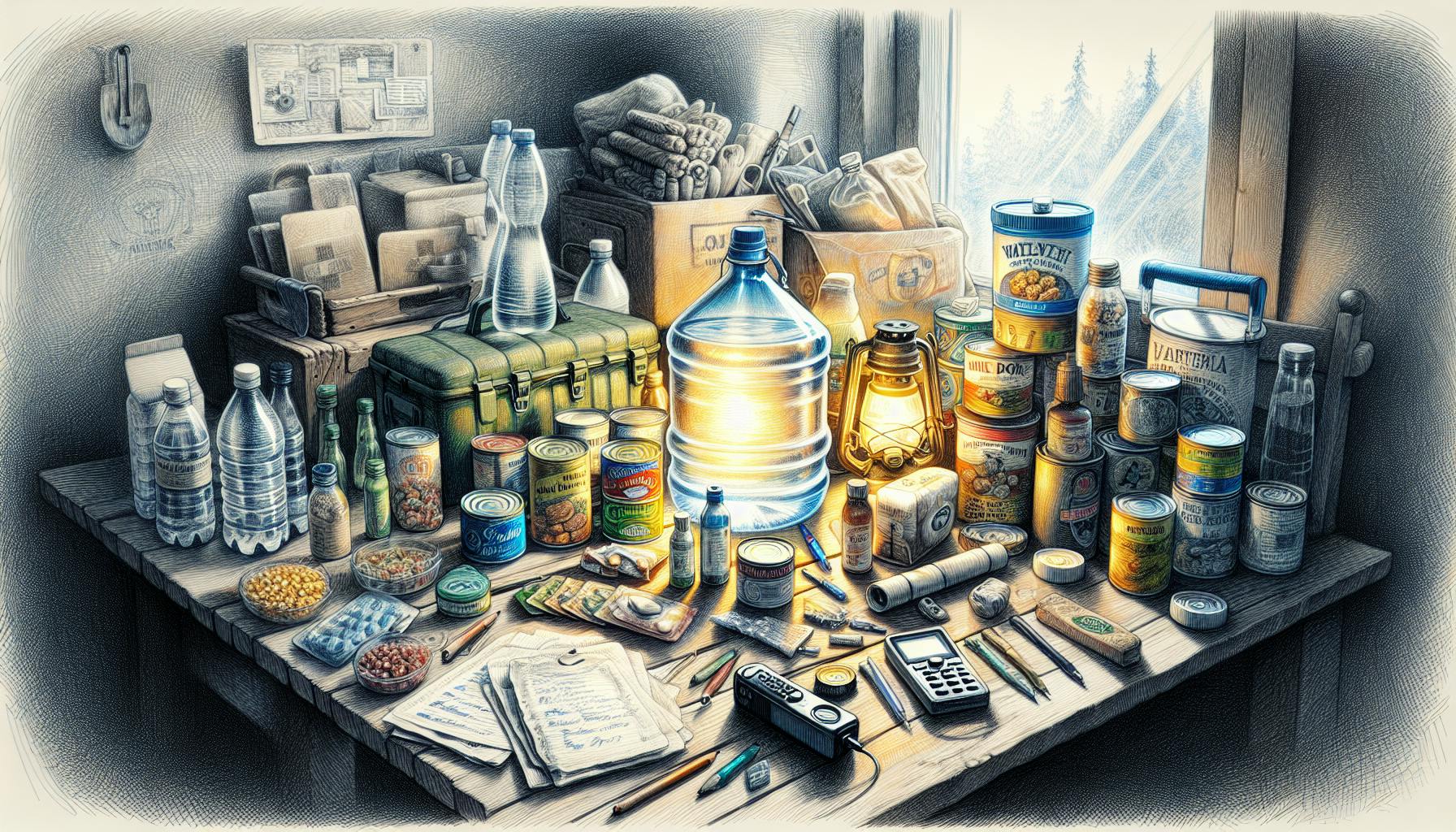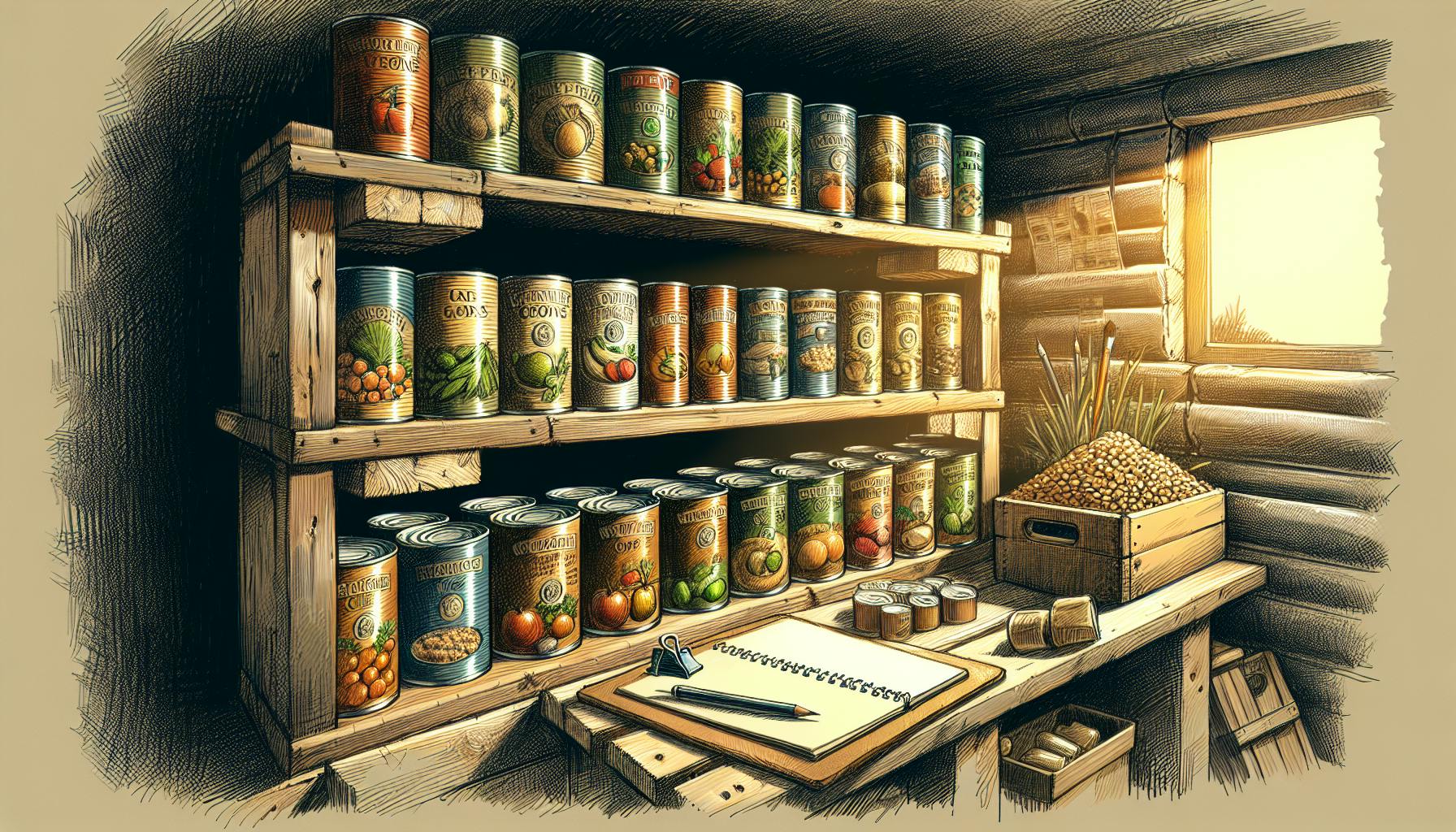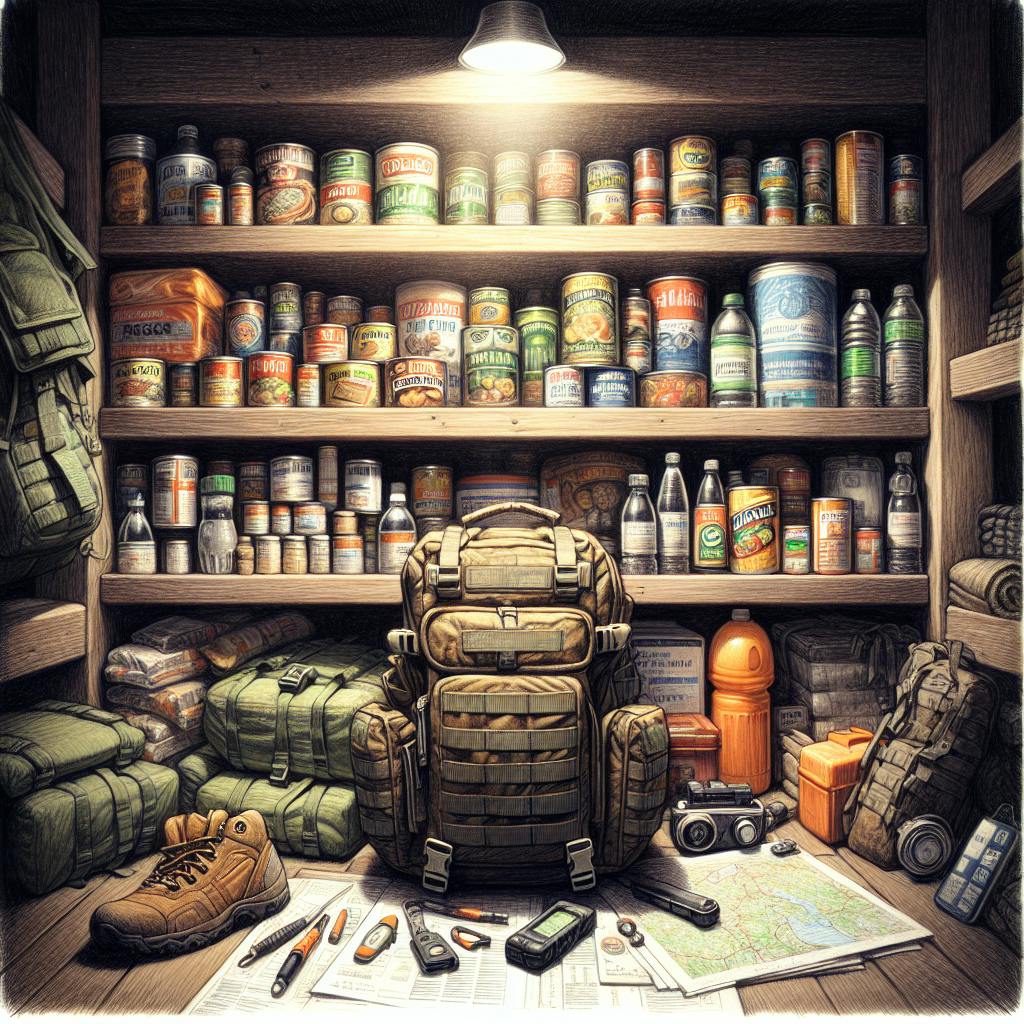When starting out in prepping, it can be overwhelming to know where to begin building your stockpile of emergency gear and supplies.
This checklist will guide you through the key types of items to look for when choosing an online prepper store, helping streamline the process of outfitting yourself with essential equipment.
You'll learn how to identify reputable sellers, compare product reviews and ratings, find wholesale pricing, and most importantly, build a comprehensive list of the survival gear you need as a beginner prepper.
Introduction to Prepping for Beginners
What is Prepping?
Prepping refers to making preparations and gathering supplies in case of emergencies or disaster scenarios. It involves stocking up on food, water, medical supplies, and other gear to ensure you and your family are prepared for events like natural disasters, power outages, economic instability, or other crisis situations.
At its core, prepping is about being self-reliant and ready for the unexpected. It gives people more control and peace of mind knowing they have the essentials to survive if traditional supply chains and infrastructure are disrupted.
Why Get Prepared?
There are many potential emergency scenarios that preppers aim to be ready for, including:
- Natural disasters like hurricanes, floods, earthquakes, tornadoes, winter storms
- Extended power grid failures
- Economic collapse or hyperinflation
- Global pandemic diseases
- Civil unrest or cyberattacks that disrupt normal life
Having supplies like food, water, first aid, lighting, and communication devices can literally be life-saving if any of these situations arise. Being prepared prevents panic and gives you greater odds of safely riding out the emergency.
It’s wise to hope for the best but prepare for the worst. Getting prepared helps minimize disruption and anxiety for you and your family if an emergency does occur.
Creating Your Prepper Checklist
When looking for an online prepper store, you’ll want to find one that supplies all the essential gear categories needed to build a comprehensive survival stockpile. We’ll cover the key items you should look for across these prepper categories later in this article:
- Food & Water
- First Aid
- Lighting
- Communication
- Self-Defense
Having reliable vendors that can supply equipment across all these critical domains is extremely important when assembling your beginner prepper checklist.
Essential Prepper Supplies for Beginners
Being prepared for emergencies starts with having the right supplies on hand. As a beginning prepper, focus first on stocking up on basic necessities like water, food, first aid, and survival gear.
Water Storage and Filtration
Having access to clean drinking water is critical in an emergency. Consider investing in:
- Water barrels for long-term storage. Look for food-grade plastic barrels that hold at least 55 gallons. Be sure to sanitize them properly before filling.
- Water filtration systems like gravity filters or straw filters. These remove bacteria and sediments, making found water sources safer to drink.
- Water purification tablets. These are portable, last 5 years, and kill waterborne pathogens.
Always store water in cool, dark areas and rotate it out every 6 months.
Long-Term Food Storage
Stock up on non-perishable foods with a long shelf life:
- Canned goods like beans, vegetables, fruits packed in juice. Opt for low sodium when possible.
- Whole grains like rice, quinoa, oats stored in airtight containers.
- Freeze-dried or dehydrated fruits, vegetables, dairy products. Rehydrate with water.
- MREs (Meals Ready to Eat). These pack a lot of calories and come in self-contained pouches.
Use the FIFO (First In First Out) method to cycle older food to the front of your stockpile.
First Aid Kits
Having the ability to treat injuries at home will be critical. Be sure to stock:
- Sterile gauze pads, roller bandages, medical tape, trauma shears.
- Antibiotic ointment, alcohol wipes, thermometer.
- Medications - pain relievers, anti-diarrhea meds, vitamins.
- First aid manual for reference.
Rotate supplies every 6-12 months to ensure freshness.
Doomsday Survival Kit List
For a worst case scenario, a go-bag should include:
- 3 days worth of food/water per person
- Weather appropriate clothing + footwear
- Sleeping bags, tents
- Portable stove, fuel, mess kits
- Flashlights, batteries
- Cash in small bills
- Maps, compass
The key is having versatile items that fulfill basic survival needs. Prioritize portability, durability, and multi-functionality in your gear selection.
By starting with these fundamental categories, beginner preppers can build a strong foundation of preparedness supplies to fall back on when it matters most.
Navigating Best Survival Gear Websites
When searching for quality survival gear, it's important to identify reputable online stores that offer a wide selection of supplies from top brands. Here are some tips for finding the best prepper websites:
Identifying Top Survival Gear Companies
Look for companies that:
- Specialize in survival/prepper gear
- Offer products from well-known tactical brands
- Have been in business for 5+ years
- Provide detailed product information
- Offer customer reviews and ratings
Reputable retailers like Sportsman's Guide, Cheaper Than Dirt, and Self Reliance Outfitters are good places to start.
Comparing Product Reviews and Ratings
- Check online customer reviews on the retailer's website as well as third party sites. This will give you a good idea of real-world product performance.
- Pay attention to star ratings and the number of reviews. Products with 4+ stars and 50+ reviews tend to perform better.
- Expert video reviews on YouTube can also provide useful insight.
Leveraging these resources helps ensure you get effective, battle-tested gear.
Finding Prepper Supplies Wholesale Options
Purchasing non-perishable items in bulk can save a lot of money. Look for:
- Bulk pricing tiers
- Free shipping above certain order values
- Coupon codes and loyalty programs
Wholesale prepper websites like My Patriot Supply and Camping Survival cater to bulk buyers. Joining their membership program provides the best bulk pricing.
Taking the time to research retailers helps you find quality survival supplies at the best possible value. Focus on highly-rated products from top manufacturers and leverage bulk purchasing when possible.
Military Tactical Survival Gear
Understanding Military-Grade Equipment
Military-grade tactical gear refers to equipment and supplies that meet the durability, performance, and reliability standards required for use by armed forces or law enforcement agencies. This type of gear is designed to withstand extreme conditions while allowing the user to effectively carry out missions or operations.
Some key advantages of military tactical gear for preppers include:
- Durability - Built to last and withstand heavy-duty use in harsh environments.
- Versatility - Designed for multiple applications and scenarios.
- Effectiveness - Provides critical survival/tactical capabilities and performance.
- Compact/lightweight - Optimized to balance utility and portability.
When sourcing tactical gear, it's important to verify items are genuinely military-spec or mil-spec certified to ensure quality.
Assessing Your Tactical Gear Needs
Determining what tactical gear you need depends on your specific prepping strategy and likely emergency scenarios. Key factors to consider:
- Climate/terrain - Gear should match expected environmental conditions.
- Threat assessment - Needed capabilities will vary based on risks like civil unrest, natural disasters, nuclear events, etc.
- Mobility requirements - Backpacks, protective equipment, etc. should align with necessary movement flexibility.
- Skill level - Opt for equipment suitable to your training; advanced gear requires practice.
- Budget - Prioritize versatile, durable gear providing the most critical functionality.
A methodical needs analysis will reveal capability gaps to address through tactical gear acquisitions.
Integrating Tactical Gear into Your Prepper Gear List
When adding tactical gear, strive to enhance your preparedness without hampering mobility or straining your budget:
- Start small - Get proven versatile basics like durable pants, boots, bags before specialized gear.
- Layer and adapt - Modular and flexible equipment enhances mobility.
- Used/surplus gear - Can provide cost savings if properly inspected and fitted.
- Cross-train gear - Multi-use items like sturdy boots or all-weather bags maximize value.
- Skill up with gear - Obtain gear aligned with training goals to master new preparedness skills.
Taking a balanced approach allows tactical gear to seamlessly integrate with well-rounded prepper supplies.
sbb-itb-b932644
Security and Self-Defense Gear
When law enforcement resources are stretched thin, personal security becomes increasingly important. This section provides recommendations for reliable tools to help keep your home and family safe.
Two-Way Radios
Two-way radios allow reliable communication over short distances without relying on cell networks. Consider the following features when selecting two-way radios for your home:
- Range - Radios with a range between 2-5 miles will cover most homesteads. Select a model with the longest range your budget allows.
- Rugged and Waterproof Design - Durability is key for radios used in emergency situations. Look for MIL-STD ratings.
- Emergency Alert Feature - Some radios have a call/alert button to signal the entire group. This can be extremely valuable in emergencies.
- Battery Life - Long battery life means the radios will work when you need them. Look for >24 hour battery ratings.
- NOAA Weather Radio - Some models can receive NOAA weather alerts, which can provide advance warning of severe storms.
The Motorola Talkabout T800 is a top choice with excellent range, ruggedness and battery life.
Perimeter Alarms and Traps
Protecting your home's perimeter can act as an early warning system and deterrent. Consider layering multiple alarms and deterrents:
- Motion-Sensing Spotlights - Inexpensive and easy to install. The bright light can deter intruders.
- DIY Alarms - String cans filled with rocks/coins around your property as an early warning signal.
- Camera Traps - Can capture images of trespassers without risking direct confrontation. Look for cellular trail cameras.
- Punji Stick Pits - Controversial but effective. Dig pits filled with sharpened sticks around your perimeter. Use caution and proper signage to avoid liability.
- Tanglefoot Paste - Apply this extremely sticky resin around areas you want to restrict access to, such as crawl space entries.
Regularly test and maintain all perimeter alarms and traps. Ensure proper liability signage is in place wherever appropriate.
Weapons and Safety Gear
In a true SHTF situation, firearms and other weapons may be necessary for self-defense. Consider the following when selecting weapons:
- Skill Level - Choose weapons aligned with your current skill level. A rifle or crossbow is easier to use effectively than a handgun or bow.
- Ammo Availability - .22 LR ammo is extremely common, making .22 rifles good choices. Stockpile ammo when prices are low.
- Legal Concerns - Ensure you follow all local and federal laws regarding legally owned weapons.
- Safety Gear - Wear eye and ear protection when training. Store guns unloaded and locked. Follow basic safety rules when handling.
Consider less-than-lethal options like pepper spray as well. Wasp spray can also be effective up to 20 feet away. Store weapons and ammo securely to prevent unauthorized access. Regularly practice to maintain proficiency.
Building a Comprehensive Prepper Gear List
Creating a well-rounded prepper gear list is essential for being ready for various emergency situations. Here are some key categories to consider when putting together your list:
The Basics: Food, Water, Shelter, and Warmth
- Food: Non-perishable foods like canned goods, MREs, protein bars. At least a 3-month supply. Consider dietary needs.
- Water: 1 gallon per person per day. Water filtration/purification supplies.
- Shelter: Tents, tarps, emergency blankets and sleeping bags.
- Warmth: Extra socks, jackets, gloves, hats, thermal underwear.
Communication and Navigation Tools
- Communication radios to stay in touch with others.
- AM/FM radios for news.
- Maps and compasses for navigation if GPS fails.
Health and Hygiene Essentials
- First aid kits for injury and illness.
- Medications - both prescription and OTC.
- Sanitation and hygiene items - toilet paper, feminine products, soap, disinfectants.
Customizing Your List for Specific Scenarios
- Floods: Life jackets, waterproof bags, sandbags.
- Earthquakes: Helmets, gloves, sturdy shoes.
- Economic collapse: Barter items, security items.
Tailor your prepper gear list to your needs, budget and potential risks in your area. Shop online prepper stores for all the best survival supplies.
Choosing a Reliable Online Prepper Store
When selecting an online prepper store, it's important to vet the company's reputation, product quality, and payment security. This helps ensure you get reliable gear at fair prices from a trustworthy seller.
Vetting an Online Store's Reputation
Before buying from an online prepper store:
- Check reviews on independent sites like Trustpilot or the Better Business Bureau. Look for consistent positive feedback over at least a few years.
- Research the company history and brand longevity. Established sellers tend to be more reliable.
- Verify transparency around business details like physical address, customer service contacts, and leadership team. This signals accountability.
Assessing Gear Quality and Variety
When browsing an online prepper store's products:
- Inspect gear specs like materials, dimensions, weight capacity, and key features. Cross-reference details on the manufacturer website when possible.
- Favor stores with a wide variety of survival items from reputable brands. This suggests an established supply chain.
- Consider niche inventory as a sign of specialty market experience and relationships.
Evaluating Price and Payment Security
To determine fair pricing and purchase protection:
- Compare prices across multiple online prepper stores, especially for big-ticket items.
- Look for discounts, coupon codes, loyalty programs, and occasional sales to reduce costs.
- Check that the site uses secure payment gateways like Stripe or PayPal. Avoid sellers only accepting bank transfers.
- Review fraud protection, refund, and privacy policies before entering payment details.
Taking the time to thoroughly evaluate an online prepper retailer helps ensure your hard-earned money goes towards reliable, quality survival supplies.
Final Thoughts
As a beginner prepper, it's important to start small and focus first on stocking the essentials before specialized gear. Here are a few final tips:
Focus First on Stocking Essentials
When putting together your prepper supply checklist, prioritize basic survival items like food, water, first aid kits, flashlights, and multi-tools. Once you've built up a stockpile of essentials, you can move on to more specialized gear.
Continue Learning and Practicing Skills
Simply buying survival equipment isn't enough. Read prepper books and take courses to gain knowledge on important skills like first aid, navigation, shelter-building, water purification, and more. Regularly practice these skills as well.
Stay Vigilant and Proactive
Use your understanding of world events to remain alert to any early warning signs of potential disasters, both natural and man-made. Continuously scan prepper websites for deals so you can keep adding to your stockpile. And review your preparedness plans frequently to address any gaps.
By starting with the basics, continuing self-education, and staying proactive, you'll be well on your way to becoming fully prepared. Check out our other articles for more tips!


